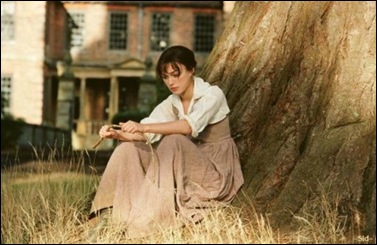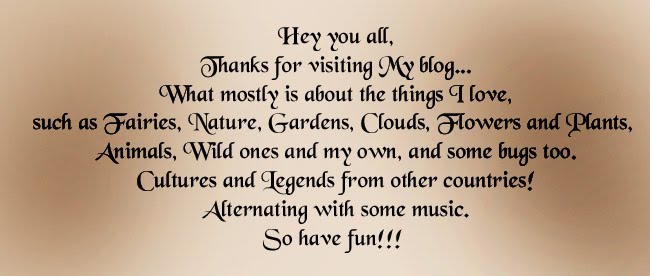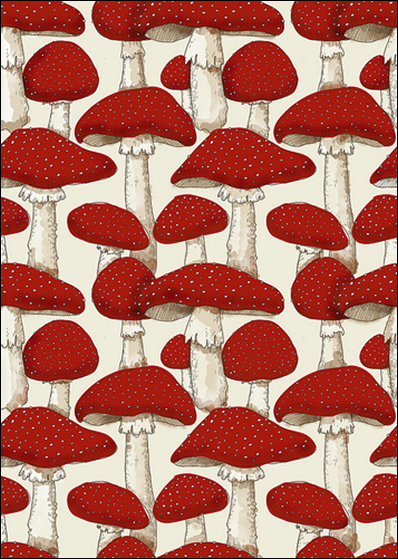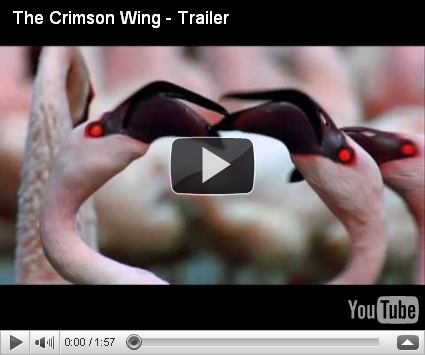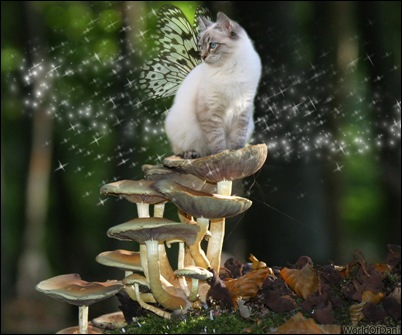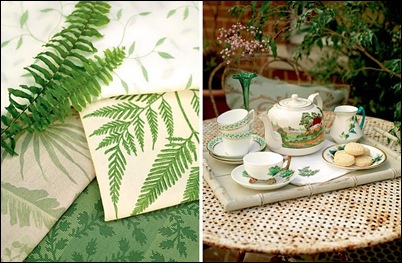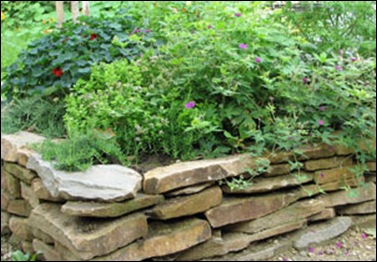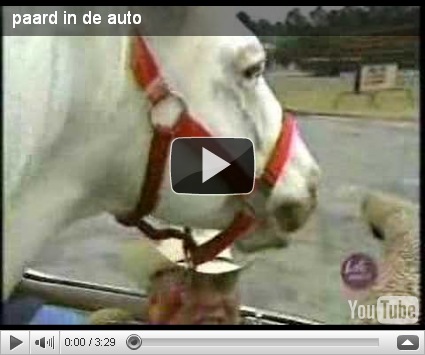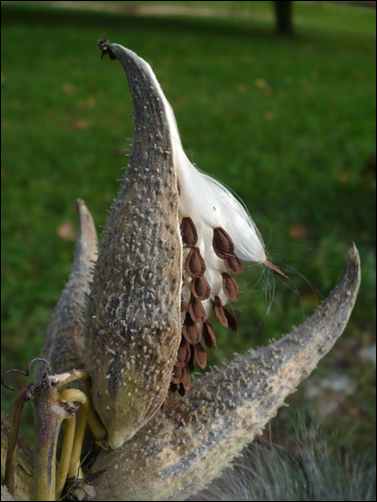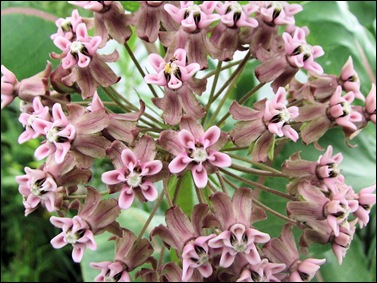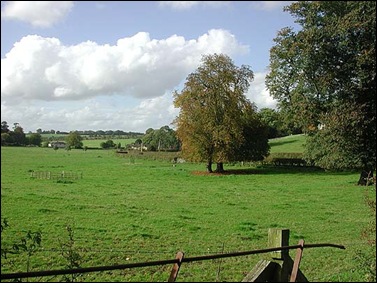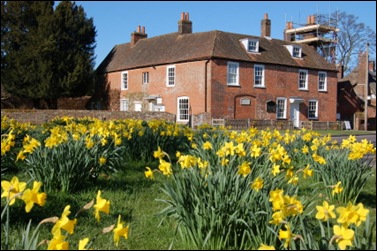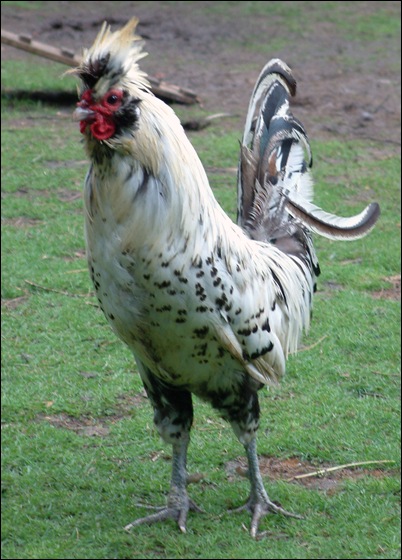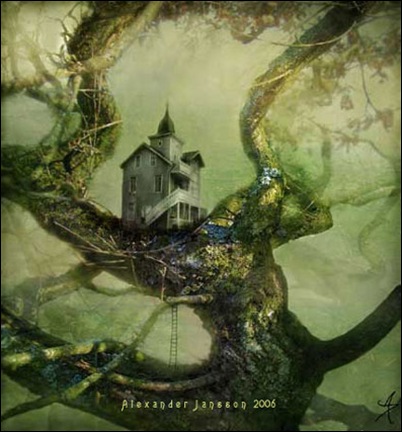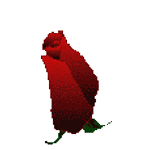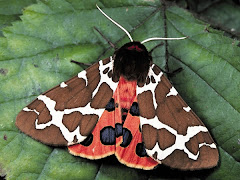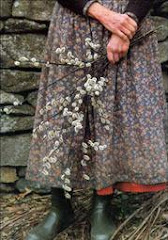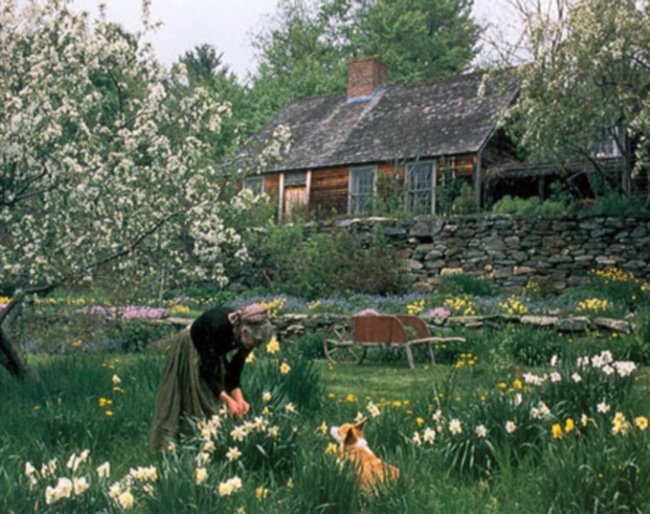ENJOY!!!
27.11.10
26.11.10
~Salangaan
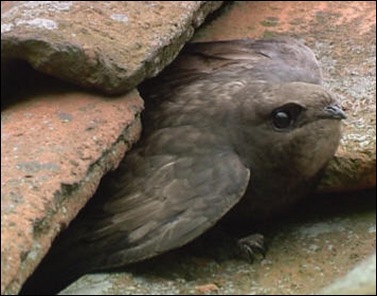
De Salangaan (Aerodramus) is een geslacht van
vogels uit de familie gierzwaluwen.
Het woord vogelnest zit in de naam van twee
verschillende Chinese gerechten, een gefrituurd
eiergerecht en de delicatesse van gedroogde
vogelnestjes van een bepaalde Aziatische zeezwaluw,
de Salangaan. Salanganen bouwen hun nestjes van
speeksel; anders dan andere zwaluwen gebruiken
ze geen takjes of modder.
De zeezwaluwen bouwen met duizenden tegelijk hun
nestjes in donkere spelonken of diepe grotten.
In de keuken wordt de delicatesse vooral
gebruikt voor vogelnestsoep.
De vogelnestjes verschillen in grootte en de zwaluwtjes
vliegen enige malen achter elkaar tegen dezelfde plek
aan de rotswand. Elke keer blijft een half
cirkelvormige streep speeksel kleven en als deze
gedroogd zijn worden er telkens nieuwe kringen
gemaakt aan de binnenzijde. De rand blijft altijd scherp
en verdikt zich naar binnen, waarin 1, 2, 3 of 4 eieren
in gelegd zullen worden.
Toch blijven de vogelnestjes piepklein waar de
zwaluwtjes maar net op kunnen gaan zitten
om te broeden. De nodige speeksel wordt afgescheiden
door de ondertongklier, die in de broedtijd tot abnormale
afmetingen uitzet. De kleur van de vogelnestjes
verschilt van diep-bruin tot een wittige tint en
zijn soms vermengd met allerlei troep zoals
veertjes, takjes, bloed en zelfs ontlasting.
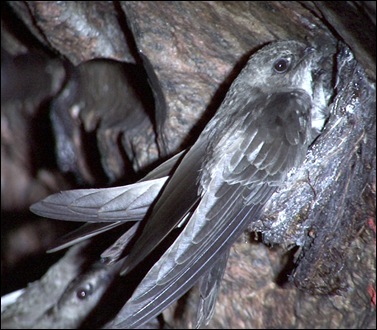
Toch wordt de voedingswaarde zeer hoog geschat
vanwege de eiwitten en vitaminen en vooral de
Chinezen schrijven aan deze vogelnestjes een
stimulerende en geneeskrachtige werking toe.
Op vele plaatsen in Azië komen de eetbare
vogelnestjes voor. De cremekleurige vogelnestjes
werden tot voor kort als de meest populaire vogelnestjes
beschouwd, doch de Chinezen geven nu vooral de
voorkeur aan de rode vogelnestjes waar bloed aan kleeft.
De prijs van deze soort kan enorm hoog
oplopen tot wel $10.000 per kilo.

Aerodramus is a genus of small, dark, cave-nesting
birds in the Collocaliini tribe of the swift family.
Its members are confined to tropical and subtropical
regions in southern Asia, Oceania and northeastern
Australia. Many of its members were formerly
classified in Collocalia, but were first placed in a
separate genus by American ornithologist
Harry Church Oberholser in 1906.
This is a taxonomically difficult group of very similar species. Echolocation, DNA sequencing and parasitic lice have
all been used to establish relationships,
but some problems, such as the placement of the
Papuan Swiftlet are not fully resolved.
These swiftlets can pose major identification
problems where several species occur.

What distinguishes Aerodramus swiftlets from
other swifts, and indeed almost all other birds,
is their ability to use a simple but effective form
of echolocation. This enables them to navigate
within the breeding and roosting caves.
The nests of Aerodramus swiftlets are constructed
with saliva as a major component.
In two species, saliva is the only material used,
and the nests are collected for the famous
Chinese delicacy 'bird's nest soup’,
the over-collection of which puts pressure
on the swiftlet populations.
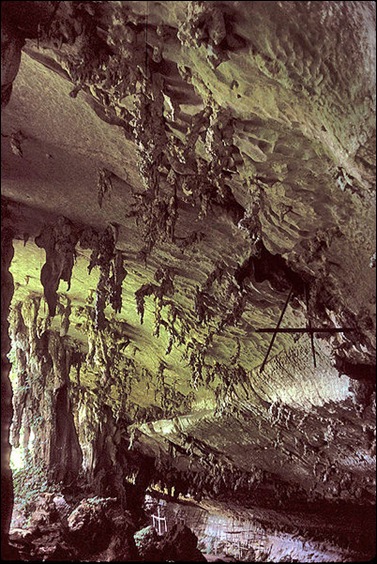
Niah cave (located within the district of
Miri in Sarawak, Malaysia), a swiftlet nesting site.
Have an Amazing
Weekend!
24.11.10
~My sweeties!

These are my 3 little Sweeties!
Kelly on the right
Chica left, and Rico in the middle!
The 2 little white doggies are just with us for 7months!
They were abused for many years
before they came to life with us!
They are very good accustomed to our lifestyle and
to Kelly, who is almost 10years old now!
23.11.10
~Fascinated by these beautiful birds!
The Crimson Wing, which chronicles the life and
struggles of the colony of two million lesser flamingos
that breed on Lake Natron in northern Tanzania.
22.11.10
~Poem
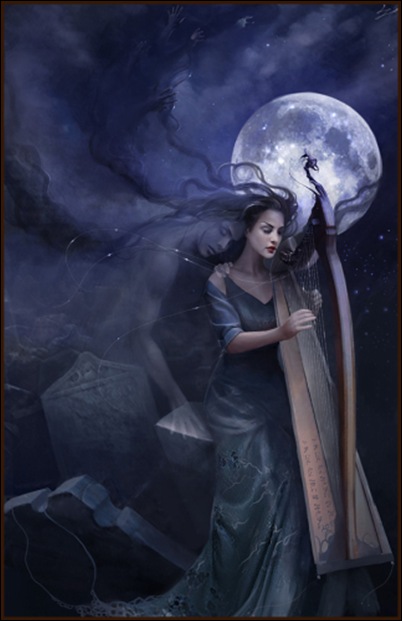 The Melody of Your Demise by Linda Bergkvist
The Melody of Your Demise by Linda Bergkvist
The wind doth blow today, my love,
And a few small drops of rain;
I never had but one true-love,
In cold grave she was lain.
‘I’ll do as much for my true-love
As any young man may;
I’ll sit and mourn all at her grave
For a twelvemonth and a day.’
The twelvemonth and a day being up,
The dead began to speak:
‘Oh who sits weeping on my grave,
And will not let me sleep?’
‘Tis I, my love, sits on your grave,
And will not let you sleep;
For I crave one kiss of your clay-cold lips,
And that is all I seek.’
‘You crave one kiss of my clay-cold lips;
But my breath smells earthy strong;
If you have one kiss of my clay-cold lips,
Your time will not be long.
Tis down in yonder garden green,
Love, where we used to walk,
The finest flower that ere was seen
Is withered to a stalk.
‘The stalk is withered dry, my love,
So will our hearts decay;
So make yourself content, my love,
Till God calls you away.’
20.11.10
19.11.10
18.11.10
17.11.10
~Incredible Bighorn Sheep
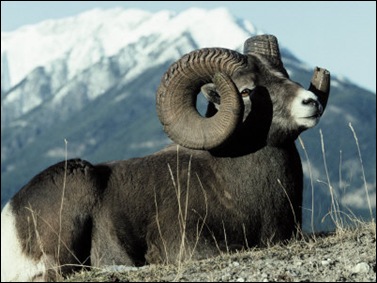
Bighorn sheep (Ovis canadensis) is a species
of sheep in North America with large horns.
These horns can weigh up to 30 pounds (14 kg),
while the sheep themselves
weigh up to 300 pounds (140 kg)
Recent genetic testing indicates that there
are three distinct subspecies of Ovis canadensis,
one of which is endangered: Ovis canadensis sierrae.
Bighorn Sheep are often confused with the Mountain Goat
(Oreamnos americanus), another mammal
that occupies mountainous regions.
~~~~~~~~~~~~~~~~~~~~~~~~~~~~~
Het dikhoornschaap (Ovis canadensis) is een
wild schaap uit de familie der holhoornigen (Bovidae).
Het dier komt voor in de Rocky Mountains en
andere berggebieden in het westen van Noord-Amerika.
Het dankt zijn naam aan de grote gekromde
hoorns van de rammen.
De soort is verwant aan het sneeuwschaap
(Ovis nivicola) en om deze reden wordt deze
Siberische schapensoort door sommigen
als ondersoort van het dikhoornschaap gezien.
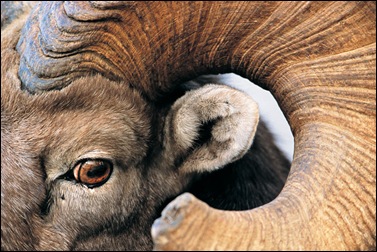
Sheep originally crossed to North America over
the Bering land bridge from Siberia: the population
in North America peaked in the millions, and
the bighorn sheep entered into the mythology
of Native Americans.
However, by 1900 the population had crashed to
several thousand. Conservation efforts
(in part, by the Boy Scouts) have restored the population.
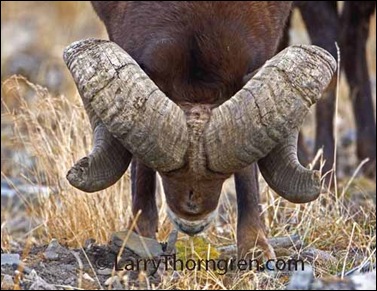
Bighorn sheep graze on grasses and browse shrubs,
particularly in fall and winter, and seek minerals at
natural salt licks. Bighorns are well adapted to
climbing steep terrain where they seek cover from
predators such as coyotes, golden eagles, and cougars.
READ MORE HERE!
~~~~~~~~~~~~~~~~~~~~~~~~~~~~~
Het dikhoornschaap is een goede klimmer en
bewoont gebieden waar weinig mensen en roofdieren
kunnen komen. Zijn hoeven zijn zo gebouwd,
dat de dieren zonder veel problemen steile rotsen
kunnen klimmen en van rots naar rots springen.
Het is een dagdier, dat in de schemering en op het
midden van de dag op zoek gaat naar voedsel.
Hij eet vooral grassen, zegge, kruiden en
bladeren van struiken 's Winters schakelt hij over
naar houtige planten als wilg en salie.
Ook likt hij aan natuurlijke likstenen voor de mineralen.
In woestijnen leeft hij meer van struiken en cacti.
's Nachts gaat hij slapen op een richel of in een grot.
LEES HIER MEER!
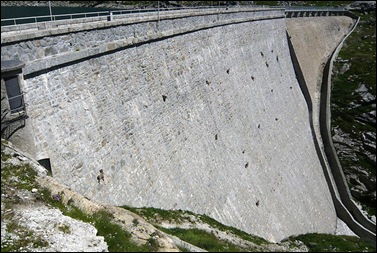
Take a close look at those dark spots
on the downstream face of the dam ...
~~~~~~~~~~~~~~~~~~~~~~~~~
Kijk eens goed naar de donkere vlekjes op de dam..
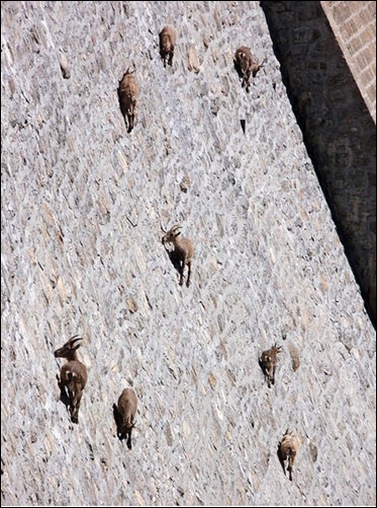
They are Bighorn sheep walking on the
near vertical face of the dam. ..
~~~~~~~~~~~~~~~~~~~~~~~~~~~~~
Het zijn dikhoornschapen die gewoon~
verticaal naar
boven of beneden lopen…

Nature is pretty incredible, Huh?
~~~~~~~~~~~~~~~~~~~~~~~~~~~~~
Wat is de natuur toch bijzonder, Huh?

LINK HERE
for the most beautiful photo’s of Bighorns
~~~~~~~~~~~~~~~~~~~~~~~~~~~~~~
KIJK EENS HIER
voor meer prachtige foto’s van de Dikhoornschapen!
16.11.10
~Love Gardening
Who would not dream of a (small) corner,
where refuge in the warmth in winter and
breathe peace, perhaps in a small greenhouse,
surrounded by flowers and plants of all kinds.
15.11.10
~Stapelmuurtjes
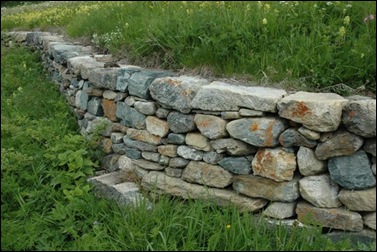
Wat zijn stapelmuurtjes?
Stapelmuren zijn drooggestapelde muren van
natuursteen zonder gebruik van cement of mortel.
Het kan zijn als steunmuur (zie foto hierboven)
of als vrijstaande muur (zie foto hieronder).
Het doel is bescherming tegen wind, sneeuw, lawines;
afbakening eigendom; tegenhouden dieren; vormen
van terrassen. Tevens vormt het een biotoop
voor zo'n 160 soorten dieren en planten.
Door de opkomst van prikkeldraad en door
ruilverkaveling is het ambacht van stapelmuurbouw
bijna uit Europa en ook uit Nederland verdwenen.
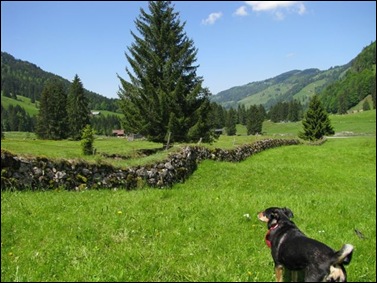
NED. TEKST HIER GEVONDEN
What is a Dry Stone Wall?
Dry stone is a building method by which structures
are constructed from stones without any mortar
to bind them together. Dry stone structures
are stable because of their unique construction method,
which is characterized by the presence of a
load-bearing facade of carefully-selected
interlocking stones. Dry-stone technology is best known
as retaining wall construction, but dry stone fences,
buildings, bridges, and other structures also exist.
A dry-stone wall, also known as a dry-stone dyke,
drystane dyke, dry-stone hedge, or rock fence is
a wall that is constructed from stones without
any mortar to bind them together.
As with other dry stone structures,
the wall is held up by the interlocking of the stones.
Such walls are used in building construction,
as field boundaries, and on steep slopes as
retaining walls for terracing.
Read More HERE and HERE
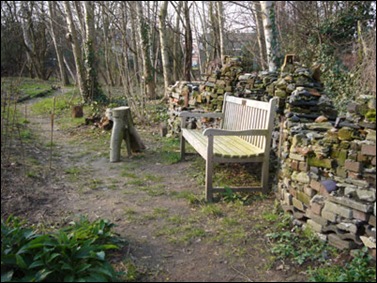
Stapelmuurtjes passen ook in elke tuin.
Ze zijn decoratief en raken al snel begroeid met
allerlei plantjes. je kunt je muurtje stapelen
van bijvoorbeeld kalksteen, graniet,leisteen en
zelfs van zandsteen. Kies voor je stapelmuurtje
kleinblijvende planten.
Bijzonder geschikt zijn rotsplanten
zoals gentiaan, wildemanskruid en het rozenkransje
(Antennaria dioica)
(ZIe de 2 foto’s hieronder)
Antennaria dioica (Mountain Everlasting, Catsfoot,
Cudweed or Stoloniferous Pussytoes) is
a flowering plant in the family Asteraceae.
It is found in cool temperate regions of Europe and Asia,
and also in North America in Alaska only.
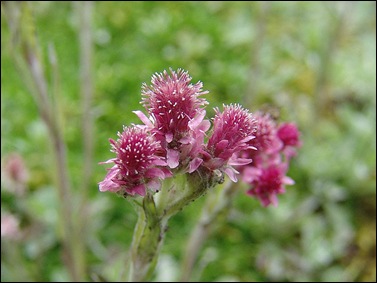
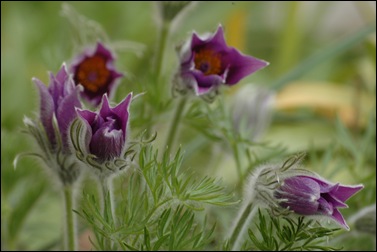
Op de foto hierboven zie je
de prachtige Wildemanskruid!
Het wildemanskruid staat op de
Nederlandse Rode lijst van planten
en in het wild niet meer aanwezig.
On the picture above you see
the wonderful Pasque Flower,
Pulsatilla vulgaris (Pasque Flower,
Common Pasque flower, Dane's Blood)
belongs to the Buttercup family (Ranunculaceae),
native to western, central and southern Europe.
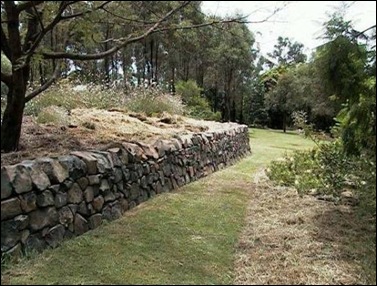
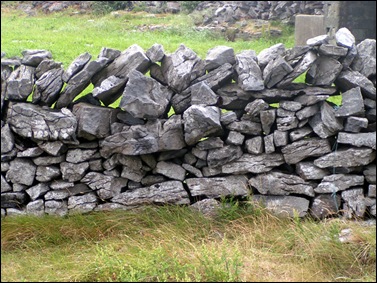 Klik op de foto’s voor de bron
Klik op de foto’s voor de bron
Click on Photo for source
14.11.10
13.11.10
12.11.10
~Milkweed
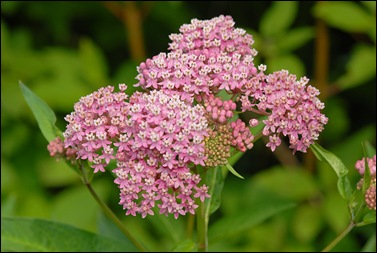
Milkweed is named for its milky juice, which
contains alkaloids, latex, and several other complex
compounds including cardenolides.
Some species are known to be toxic.
Carl Linnaeus named the genus after Asclepius,
the Greek god of healing, because of the many
folk-medicinal uses for the milkweed plants.
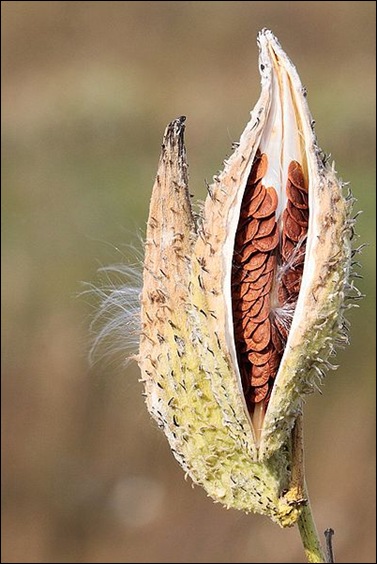
Milkweeds (Papegaaiplant / zijdeplant)
is een belangrijke nectarbron voor bijen
en andere nectar naar insecten streven, en een
larvale voedselbron die voor monarch vlinders en
hun verwanten, evenals een verscheidenheid
van andere herbivorous insecten
(met inbegrip van talrijk kevers, motten, en ware insecten) gespecialiseerd aan voer op de installaties ondanks
hun chemische defensie.
Milkweed wordt zo genoemd vanwege zijn melkachtig sap,
dat bevat alkaloïde, caoutchouc, en verscheidene
andere complexe samenstellingen met inbegrip
van cardenolides.
Sommige soorten zijn gekend om te zijn giftig.
LEES HIER MEER!
Pollination in this genus is accomplished in an unusual
manner. Pollen is grouped into complex structures
called pollinia (or "pollen sacs"), rather than being
individual grains or tetrads, as is typical for most plants.
The feet or mouthparts of flower visiting insects
such as bees, wasps and butterflies, slip into one
of the five slits in each flower formed by adjacent
anthers. The bases of the pollinia then mechanically
attach to the insect, pulling a pair of pollen sacs free
when the pollinator flies off. Pollination is effected
by the reverse procedure in which one of the
pollinia becomes trapped within the anther slit.

Asclepias species produce their seeds in follicles.
The seeds, which are arranged in overlapping rows,
have white silky filament-like hairs known as pappus,
silk, or floss. The follicles ripen and split open
and the seeds, each carried by several dried pappus,
are blown by the wind.
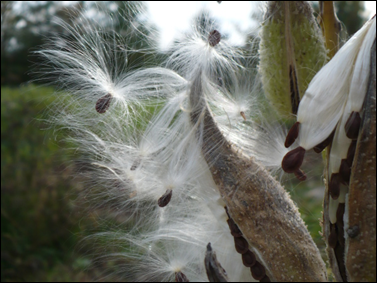 Photo's Via
Photo's Via
MORE INFO HERE
10.11.10
~A Walk with Jane Austen~

"...Flowers are very much worn, and fruit
is still more the thing.
Elizabeth has a bunch of strawberries,
and I have seen grapes, cherries, plums,
and apricots.
There are likewise almonds and raisins,
French plums, and tamarinds at the grocers’
but I have never seen any of them in hats."
Jane Austen 1799
Jane Austen loved a garden. She took a keen interest
in flower gardening and kitchen gardening alike.
The Austens grew their own food whenever they could
and had flower gardens wherever they lived, at their
parsonage at Steventon in Hampshire, their town
gardens at Bath and Southampton, and when
they returned to Hampshire, at their cottage garden
at Chawton. In Jane’s letters to her sister Cassandra,
we see her planning the details of these family gardens,
discussing the planting of fruit, flowers, and trees
with enthusiasm. In the course of her life, she also
had the opportunity to visit many of the grander
gardens of England: her brother’s two estates
at Chawton and Godmersham, the manor houses
of friends and family, and probably even the
great estate at Chatsworth, assumed by many
to be the inspiration for Pemberley…
So begins the book
“In the Garden with Jane Austen,”
by Kim Wilson,
author of Tea with Jane Austen,
published by Jones Books [2008]
Main Residences
- Steventon Rectory. The Rectory was demolished in 1820
but Steventon Church, where the Austens worshipped,
still remains. If you visit the field where the house
stood, you can see a metal pump (that replaced the
wooden pump from Austen's time) and a lime tree
that is thought to have been planted by Jane's eldest
brother James. Note that Jane spent some time away
from home during this time. In the Spring of 1783,
according to her family tradition, she and Cassandra
were sent to reside with tutor Mrs. Ann Crawley,
who lived in Oxford but moved to Southampton in
the Summer of that year. Around this time, Cassandra
and Jane both caught typhus; Jane nearly died.
Soon after, both girls returned to live at Steventon Rectory. Between the Spring of 1785 and December of 1786,
Jane and Cassandra attended Reading Ladies'
Boarding School in Berkshire.
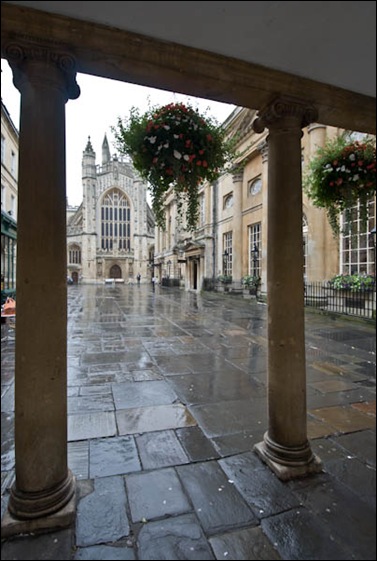
-
1801–1806: Bath, Somerset, U.K. - Her family moved several times whilst in Bath.
Their addresses were as follows: 4 Sydney Place, at the eastern end of Great Pulteney Street (until 1804);
3 Green Park Buildings East (1804–1805);
25 Gay Street (1805); and Trim Street
(1806, house number unknown). -
- Jane, Cassandra, their widowed mother
(Cassandra Leigh Austen), Francis Austen, and
Mary Austen (maiden name Gibson) all moved to
lodgings in Southampton (October 1806).
They then all moved to 3 Castle Square (March 1807).
This was described as a “commodious old-fashioned”
house and was rented from the Marquess of Lansdowne.
The house no longer exists because the whole Castle Square area has been redeveloped. -
- Chawton Cottage. This is now open to the public as the Jane Austen's House Museum.
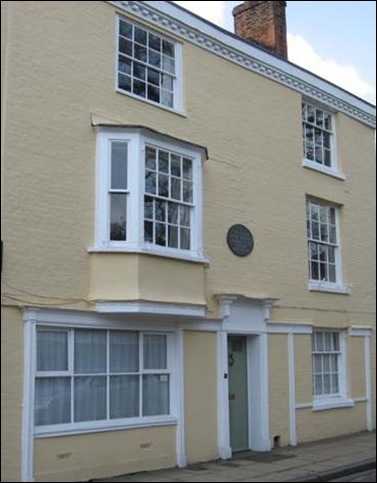

Jane’s last poem written July 15th:
When Winchester Races.
When Winchester races first took their beginning
It is said the good people forgot their old Saint
Not applying at all for the leave of Saint Swithin
And that William of Wykeham’s approval was faint.
The races however were fixed and determined
The company came and the Weather was charming
The Lords and the Ladies were satine’d and ermined
And nobody saw any future alarming.–
But when the old Saint was informed of these doings
He made but one Spring from his Shrine to the Roof
Of the Palace which now lies so sadly in ruins
And then he addressed them all standing aloof.
‘Oh! subjects rebellious! Oh Venta depraved
When once we are buried you think we are gone
But behold me immortal! By vice you’re enslaved
You have sinned and must suffer, ten farther he said
These races and revels and dissolute measures
With which you’re debasing a neighboring Plain
Let them stand–You shall meet with your
curse in your pleasures
Set off for your course, I’ll pursue with my rain.
Ye cannot but know my command o’er July
Henceforward I’ll triumph in shewing my powers
Shift your race as you will it shall never be dry
The curse upon Venta is July in showers–’.

